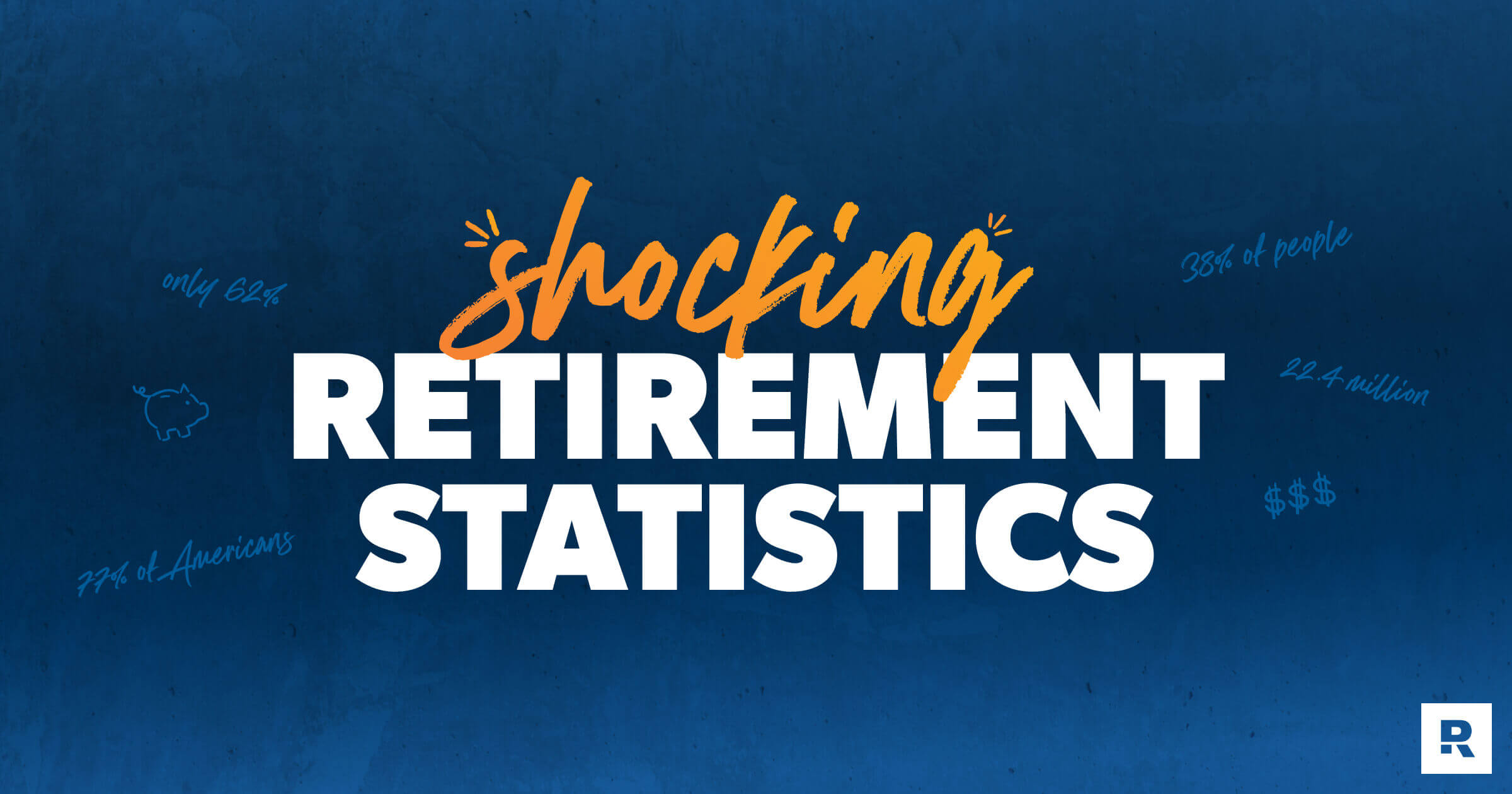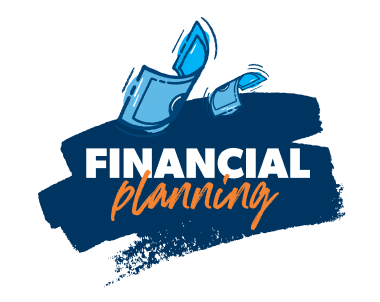10 Alarming Retirement Statistics You Can’t Ignore
8 Min Read | Mar 26, 2025

Key Takeaways
- Many Americans are struggling with debt, living paycheck to paycheck, and not saving enough for retirement. Most folks (66%) feel they’re behind on retirement savings.1
- If you’re hoping Social Security will come to the rescue, don’t count on it. The average Social Security retirement benefit is only around $24,000 per year, which is nowhere near enough money to support a comfortable retirement.2
- Americans have racked up more than $1.2 trillion in credit card debt, which really puts a strain on their top wealth-building tool: their income.3 In fact, many Americans have more credit card debt than retirement savings.
- Many Americans don’t know how much they need to save for retirement, and only 41% use a financial advisor to help with their investments.4
- Still, there’s hope for retirement success. Most millionaires built their wealth through consistent investing in retirement accounts like 401(k)s, proving that disciplined financial habits over time can lead to a secure retirement—no matter your income level.
For certain folks, there’s something they find more frightening than snakes, spiders, and even (gulp) public speaking. Nope—it’s not even a trip to the DMV. We’re talking about retirement.
Get expert money advice to reach your money goals faster!
In fact, a recent survey found that 61% of working Americans are more scared of retirement than death.5 But listen, you shouldn’t be afraid of your golden years. They’re supposed to be “golden” for a reason!
We’re not showing you these alarming statistics to scare you—we just want you to be aware of what happens if you don’t take control of your finances.
Hopefully, these numbers will get you fired up and wired up to start preparing for the future. Because if you don’t, you might wake up someday with a lot of gray hairs on your head but no money in your nest egg, wishing you had started saving a whole lot sooner.
37% of Americans have more credit card debt than retirement savings.
According to Ramsey’s State of Personal Finance report, more than a third of Americans (37%) have more credit card debt than retirement savings. That’s over 90 million U.S. adults. That’s crazy! And we’re not even including other kinds of debt like student loans or auto loans in this equation.
If you’re in that 37%, you’re setting yourself up for a boatload of trouble down the line, especially in retirement.
Social Security payments are around $25,000 a year.
Thinking about relying on Social Security for retirement? Think again. As of August 2025, most retired people got an average of $2,008 per month from Social Security. That’s only $24,096 a year.6
Do you think that’ll be enough for your retirement? We don’t either. In fact, even the Social Security Administration has said Social Security isn’t meant to replace all of your income.7
Only 62% of Americans own stocks.
Only 62% of Americans said they own stocks, which means the other 38% haven’t invested in the stock market at all.8 Yikes! But there’s at least some good news—that’s a nice jump from 52% almost a decade ago.
So, while we’re headed in the right direction, we still have a lot of work to do. If you’re part of that 38%, it’s time to get started on your investing game! (That is, if you’re financially ready to invest.) If you’ve heard us say it once, you’ve heard us say it a thousand times: You need to build wealth!
38% of people in debt are either struggling or in crisis with their money.
According to research done by Ramsey Solutions, 38% of Americans who have debt say they’re either struggling financially or in crisis, compared to 22% of people without debt. One of the biggest problems with debt is that it takes away your most important wealth-building tool: your income.
Every dollar you send to some bank or lender each month is one less dollar you can use to save and invest for the future. Is it surprising that people who have debt are more likely to feel overwhelmed, worried and stressed than those who have no debt?
That’s a great reason to pay off all debt (except your mortgage) with the debt snowball method before you even think about investing for retirement. The faster you get out of debt and free up hundreds (or even thousands) of dollars of your income, the more you’ll be able to invest and build wealth in the future.
67% of American workers are living paycheck to paycheck.
There’s no getting around the fact that every day is terrifying when you’re living paycheck to paycheck. The trouble is, about a third (67%) of Americans are doing just that.9
How can you possibly build enough wealth to retire if your bank account keeps hitting zero? If this is where you’re at right now, put all your investing on hold.
Because right now, it's time to walk the Baby Steps. Save up $1,000 for a starter emergency fund as quick as you can, then begin paying off your consumer debt—with lots of intensity. You can do this!
22.4 million Americans can’t afford their rent.
Recent research from Harvard shows that half of all American renters are struggling to pay their rent. In fact, an all-time record of 22.4 million renters are spending more than 30% of their income on rent and utilities.10
If you’re having trouble fitting rent into your budget, it’s time to:
- Pause investing
- Cut back on spending
- Increase your income
- Look around for somewhere less expensive to call home
Shelter—which includes rent—is one of the four basic expenses (the others are food, utilities and transportation) you need to cover before you worry about anything else.
You should secure the roof above your head before you even start the Baby Steps—let alone invest for retirement. Do what you need to do to fix the problem so you can get back on track. You’ve got this!
Americans have over $1.2 trillion in credit card debt.
This should really get your attention: A study done by Ramsey Solutions found that 1 in 3 Americans say they’re relying on their credit cards more than normal, and 1 in 4 had maxed out a credit card in the last 90 days.
In fact, as of the middle of 2025, Americans have over $1.2 trillion in credit card debt.11 Again, that’s just credit card debt. Surely we’re not the only ones who think this is a terrible idea.
Debt is a thief. Trying to save for retirement while holding onto your debt is like running a marathon with a backpack full of bricks—you’re not going to make it with all that extra weight. As long as you have these blood-sucking credit card companies draining your income every month, you’ll always be in catch-up mode.
Only 35% of non-retired people feel on track with their retirement savings.
Even though retirement is a top goal, two-thirds of Americans (65%) feel behind on their retirement savings—a scary feeling.12 But (spoiler for the next stat) almost half of American workers haven't even figured out how much they need to save for retirement.
Make an Investment Plan With a Pro
SmartVestor shows you up to five investing professionals in your area for free. No commitments, no hidden fees.
Only 1 in 4 workers have written down their financial strategy for retirement.
Any big achievement or goal—like funding your retirement—requires a strategy for success. And one of the best ways to achieve any goal is to write it down. And yet, even though most workers (70%) say they have some kind of financial strategy for retirement, only 26% actually have a plan written down.13 That’s not going to cut it, people!
If you still need to figure out how much you’ll need to save up for your golden years, our free retirement assessment tool can help you calculate how much you’ll need in your nest egg to enjoy the kind of retirement you’ve always dreamed of—and what you’ll need to invest each month to get there.
Only about 4 in 10 of Americans use a financial advisor.
A majority of Americans in 2025 either aren’t getting professional financial advice or are getting it from a family member.14 Trying to save for retirement without a pro on your side is like wandering into the wild without a guide (or even a decent plan). You’re going to get lost . . . or worse.
There’s a reason why 68% of millionaires said they worked with a financial advisor to help them reach their net worth goals. Millionaires recognize that they don’t have all the answers. And they’re not afraid to seek out the wisdom of someone who can help them get where they want to go. Do yourself a favor and get connected with an investment pro.
Retirement Statistics to Give You Hope
Wow—after all those dreary numbers, we bet you could use some positive news about retirement. Kind of like watching your favorite comedy after a scary movie so you don’t have nightmares. Well, here’s some good news from Ramsey’s National Study of Millionaires:
- 8 out of 10 millionaires invested in their company’s 401(k) to help them reach their net worth. You don’t have to hit the lottery, make risky single-stock investments, or inherit a fortune to retire a millionaire.
- 3 out of 4 millionaires said regular, consistent investing was the key to their success. And 79% didn’t receive an inheritance to get there.
- What careers produce millionaires? The top five are engineers, accountants, teachers, managers and attorneys. In fact, only 15% of millionaires held senior leadership roles (CEO, CFO, COO, etc.). No matter what you do for work, you can build wealth and reach a seven-figure net worth over time.
- 93% of millionaires said they got their wealth because they worked hard, not because they had big salaries. Anyone can and should be able to retire well in America today.
In spite of all the bad news out there, the American dream is not only alive and well but freely available too. If you start today, it’s not too late to change your financial picture.
Listen, your retirement years don’t have to be troubling or frightening. It’s time to get rid of the fear, take charge of your finances, and make better decisions going forward.
Next Steps
- Ramsey’s Complete Guide to Investing can help you learn everything you need to know about investing—from 401(k)s to mutual funds and everything in between. And the best part? It’s free!
- With our Investment Calculator, you'll find out how much you can expect to have in your retirement portfolio based on how much you’re saving (or want to save).
- If you’re ready to invest, find an investment pro who’ll stick with you for the long haul and help you stay on track. Our SmartVestor program is a free way to get connected with investment professionals who can help you plan for your retirement future.
This article provides general guidelines about investing topics. Your situation may be unique. To discuss a plan for your situation, connect with a SmartVestor Pro. Ramsey Solutions is a paid, non-client promoter of participating Pros.



